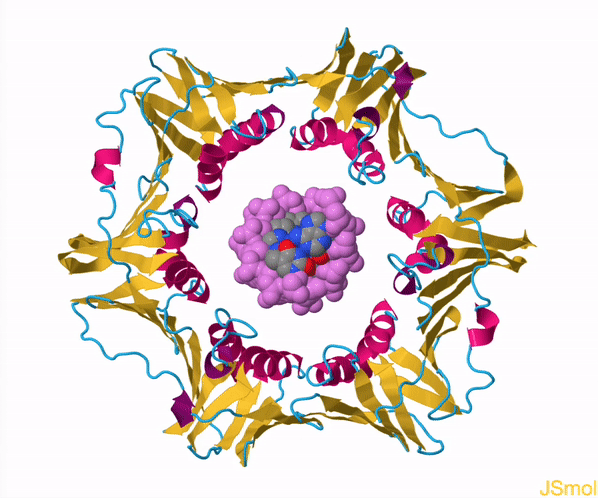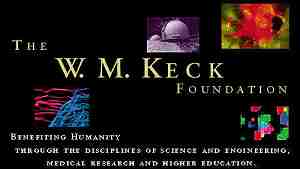<
exhibits > |
|
|
< about the OMM > |
The
Online ...serving
biomolecular visualizations |
< ware > |
<
WWW links > |
 |
|
< methods > |
<
feedback > |
Please use the <feedback> link above for comments on this site
About this site
| n. [L. <Gr. mouseion, place for the muses or for study < mousa, Muse] an institution, building, or room for preserving, studying, and exhibiting artistic, historical, or scientific objects (Webster's Second College Edition Dictionary) |
The Online Macromolecular Museum (OMM) is a site for the display and study of macromolecules. Macromolecular structures, as discovered by crystallographic, NMR, or cryo-EM methods, are scientific objects in much the same sense as fossil bones or dried specimens: they can be archived, studied, and displayed in aesthetically pleasing, educational exhibits. Hence, a museum seems an appropriate designation for the collection of displays that we are assembling. The OMM's exhibits are interactive tutorials on individual molecules in which hypertextual explanations of important biochemical features are linked to illustrative renderings of the molecule at hand.
Why devote a site to detailed visualizations of different macromolecules? In learning about the intricacies of life processes at the molecular level, it is important to understand how natural selection has fashioned the structure and chemistry of macromolecular machines to suit them for particular functions. This understanding is greatly facilitated by the visualization of 3-dimensional structure, when known. So, if static views of molecules (even in stereo) are worth a thousand words, then interactive animations of molecules should be worth much more. Indeed, we have found the types of displays represented here invaluable in gaining an appreciation for the details of key biochemical processes.
As Carl Brandon and John Tooze stated in their classic text, Introduction to Protein Structure:
| "Molecular biology began some 40 years ago with the realization that structure was crucial for a proper understanding of function. Paradoxically, the dazzling achievements of molecular genetics and biochemistry led to the eclipse of structural studies. We believe the wheel has now come full circle, and those very achievements have increased the need for structural analysis at the same time that they have provided the means for it." |
The OMM is part of a collaborative effort by faculty and students interested in macromolecular structure-function relationships. The primary authors of some exhibits are students of David Marcey and he serves as author, co-author and site editor, and assumes all responsibility for content. Any criticisms, suggestions, comments, or questions should be sent to him at: marcey@callutheran.edu. All OMM exhibits are copyrighted.
The OMM was started in 1996 for a Molecular Biology class at Kenyon College in Gambier, Ohio, where DM was a professor in the Biology Department (1990-1999). The OMM is now developed and housed at CLU, where DM has been a professor since 1999.
The exhibits are under continual construction. We thank you for your patience, and hope you enjoy the current exhibits.
Contributions of detailed macromolecular tutorials from other sources are welcome! If you are interested in providing additions to the OMM collection, please contact DM.
| [Back
to top] [About
this site] [Required software]
[Links of interest] [Methods] |
Required software
- For MacOSX+ users the Safari Browser works well, but we recommend Firefox.
- For PC users, Firefox, Chrome, and IE work well. We recommend Firefox.
This site is best viewed with a screen resolution of 1024x768 or higher, although 800x600 still looks satisfactory. We suggest a display of at least 256 colors.
[Back
to top] [About
this site] [Required software] [Links of interest] [Methods] |
Links of interest
In
addition to links related to specific macromolecules (found in individual
exhibits), here are a few of the numerous WWW sites concerned with macromolecular
modeling that we find particularly useful.
The following links open in a new browser window.
| Links of Interest:
|
[Back
to top] [About
this site] [Required software] [Links of interest] [Methods] |
History/Methods
The OMM was started in 1996 using CHIME (CHemical mIME) software written by Tim Maffet and Bryan van Vliet at MDL Information Systems. Their tour de force effort, allowing web-based visualization of structure files with the Netscape Navigator browser, was based on the excellent, open-source RasMol (Raster Molecules) program, written by Roger Sayle. Cessation of CHIME development and support in 1998, coupled with Apple Macintosh incompatibility, provided the impetus to switch OMM exhibits to run using the Jmol java applet, another open-source visualization program developed and updated by a variety of authors, most notably Bob Hanson at St. Olaf in recent years. The move to JSmol, an HTML5- compatible applet (Bob Hanson) was prompted by the increasing use of mobile devices/tablets that do not support Java. All OMM exhibits are being converted to JSmol.The exhibits were created by using Jmol scripts to illustrate structural/chemical features of macromolecules. Some of the sites found in the Links of interest section have materials describing the construction of Jmol web pages.
The molecules and
scripts are read by JSmol. Most molecular files (*.pdb) were downloaded
from the Protein
Data Bank. In some cases (noted in individual exhibits), the *.pdb
files for particular molecules were modified using Hyperchem or
DeepView or Jmol molecular modeling software, or created de novo with Hyperchem.
The *.pdb files are gnu-zipped to minimize download time, but some are
still quite large (~1Mb+), so please be patient.
[Back
to top] [About
this site] [Required software] [Links of interest] [Methods] |
Acknowledgements
The authors wish to thank the federally-funded Protein Data Bank. Thanks to Tim Maffett of MDL Information Systems for helpful advice that got us started in 1996 and for providing online info on Chime scripting. Kudos to Eric Martz (U. Mass.) for promoting biomolecular visualization. Special thanks to the Jmol development team for creating the open source applet for molecular pedagogy on the WWW. Please see the Jmol site for more information.
Most importantly, thanks to the many structural biologists and chemists whose work is the basis of the OMM displays!
The OMM has been supported in part by a grant from the W.M. Keck Foundation and by an endowed chair fund made possible by The Fletcher Jones Foundation and CLU.
![]()
[Back
to top] [About
this site] [Required software] [Links of interest] [Methods] |


